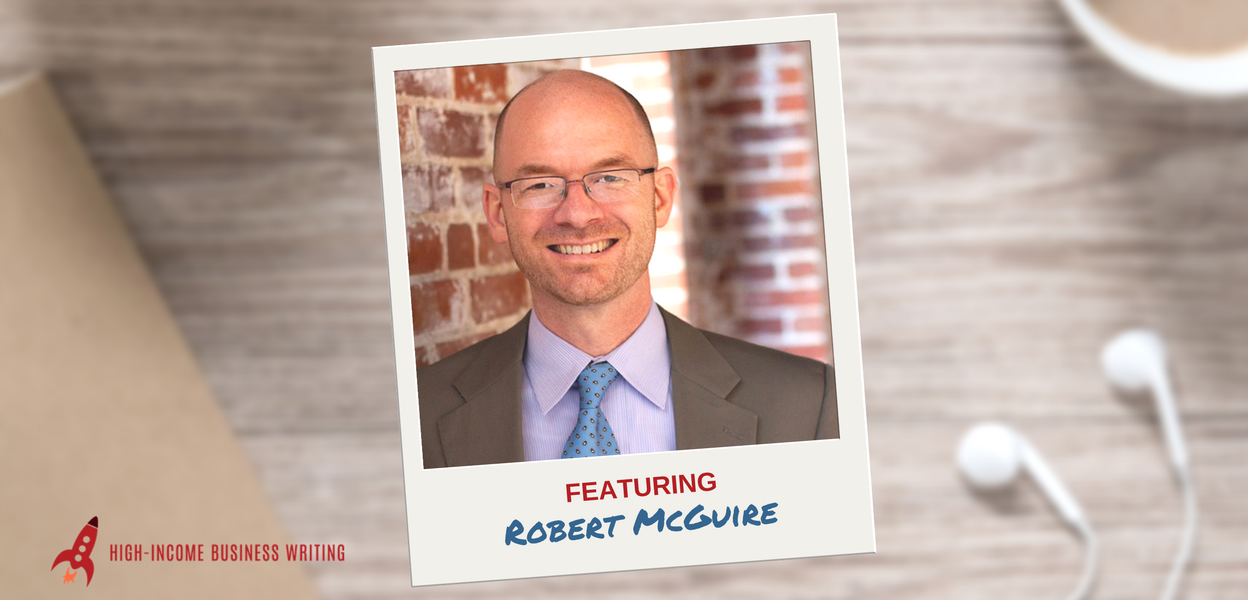I remember the blank stares I got in 2006 when I told friends and relatives that I quit my day job to go freelance.
Back then, very few people understood what freelancing was … or that anyone could earn a living writing from home.
Boy, has that changed!
Over the past 10 years, there has been a ton of information published about the freelance economy. Freelancing and consulting no longer mean “I’m between jobs.” And experts and economists are finally recognizing that we’re a real (and growing) segment of the labor force—not a temporary fluke.
But exactly how many people are freelancing? Are the big numbers we’re reading an accurate representation of the freelance workforce? And what do these numbers and projections mean for us?
That’s the topic of this week’s episode. My guest, Robert McGuire—whom we had on the podcast last year to talk about “demonstration projects”—is going to pull apart these numbers and predictions and give us his take on what’s really happening in the gig economy.
The notes that follow are a very basic, unedited summary of the show. There’s a lot more detail in the audio version. You can listen to the show using the audio player below. Or you can subscribe in iTunes to get this show delivered straight to the Podcasts app on your smart phone, tablet or iPod.


High-Income Business Writing with Ed Gandia
#140: Ultimate Guide to Gig Economy Data: A Summary of Every Freelance Study We Can Find
Tell us about yourself
Robert McGuire describes his journey from reporter to freelance writer to content marketer in podcast episode 114.
Today, his content marketing consulting business specializes in education technology startups. With his team of freelance writers, editors and designers, he develops blogs, white papers and ebooks for clients.
In addition, Robert runs a website that focuses on the business side of independent contracting, called Nation1099.
You recently spent some time researching the growth of the freelance workforce. What motivated you to do it?
We’ve all seen headlines about the growth of the freelance workforce—often with eye-popping numbers. Because the audience for Nation1099 are freelancers, Robert wanted to look at those numbers more closely. So he hunted down some of the most frequently quoted surveys and did some analysis.
How valid are the numbers?
In Daniel Pink’s 2011 book Free Agent Nation, he talked about how hard it is to find real numbers for the gig economy. Fifteen years later, not much has changed.
It’s hard to assess exactly what percentage of the workforce is working as fulltime freelancers. Unfortunately, freelancers are often lumped in with other groups in surveys (including U.S. government data), so it’s hard to get an accurate picture.
What’s your best assessment?
Full-time independent contractors (who’re working in lieu of traditional employment) make up about 11 % of the U.S. workforce.
This number is less than what you see in headlines. However, that number is on the rise. It has doubled in the last 15 years and is projected to grow by 3.5% or so per year.
The larger numbers you sometimes hear often include a much broader group of people, such as those working for temp agencies, one-time Uber drivers, etc.
What are some of the most interesting insights you uncovered?
According to some of the reports, more than 80% of highly skilled professional freelancers say that freelancing is their most preferred form of work.
Fifty percent of freelancers say they would not go back to traditional work at any price.
Some of these freelancers might have gotten into freelancing as the result of layoffs, etc. But now this is their preferred mode of work. They aren’t trying to secure a traditional job.
How do you define the terms freelancer, consultant, independent contractor?
Unfortunately, these terms are used inconsistently across different studies, which makes it hard to compare numbers.
Take the term “gig economy,” for example. We may think that we are participating in the gig economy. But some studies use the term to include people who’re delivering relatively low-skill personal services, such as driving, house cleaning, and pet sitting.
What changes have you seen in the gig economy?
Ten years ago, a CFO “for hire” was rare thing. If you wanted to hire a freelance CFO, you had to find one by word of mouth. But today, for hire CFOs are much more common, and many actively market themselves!
Talk to us about what you found in terms of income vulnerability
Earnings data for professional freelancers shows that more than 20% of us make over $100,000 per year. Skilled professional freelancers beat average household income levels in the U.S.
More than 20% of freelancers make over $100,000 per year.
Of course, that doesn’t happen by accident or luck. High-income freelancers earn more than their peers because they do things differently.
However, Robert’s hunch is that there’s a dangerous middle ground. Creative service providers (such as writers and graphic designers) are facing downward price pressures. You can’t rest on your existing skills and market in the gig economy.
To succeed in the freelance economy, you must be a problem solver, not an order taker.
There’s tons of literature on positioning for small and medium-size businesses and Fortune 500 companies. But there’s hardly anything out there for freelancers!
As a workforce, we’ve been trained in the “Tell me what you need done, and I’ll do it” mindset. We have to learn to think differently.
In the professional creative class, a lot of folks experience more income security as a freelancer. In traditional jobs, salaries have been stagnating for a generation. If you want to take command of your fate, you have to go solo. And when you go solo, you get the added security of diversifying your income stream by having multiple employers.
You mentioned that many companies aren’t prepared for this trend. Can you expand on that?
When 11% of the talent pool has removed themselves from hiring consideration because they’re freelancing, you have to take that into account. Your competition for hiring qualified candidates isn’t the tech company next door. It’s self-employment.
Yet even though this group is large, everything in the economy remains organized around traditional employment, including healthcare, taxes, job classification and even software seat licenses.
Tell us more about Nation1099
Nation1099 is aimed at entrepreneurial independent contractors. Its goal is to educate, empower and encourage solopreneurs in the gig economy, including artists, consultants, designers, developers, marketers, writers and other creative professionals.
To find the data and sources cited in this interview, visit this page on their website.






